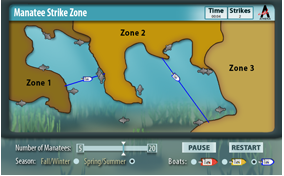Manatee Strike Zone

During the first six months of 2011, 46 manatees in Florida were killed by encounters with boat propellers. As many as 100 other manatee deaths could be in some way attributed to interactions with humans and boating activities. Your challenge is to study manatee movement patterns and determine where the safest place is to locate a series of boat docks. Make sure that you do a good job; the lives of many manatees depend on your expertise.
What is a manatee?
A manatee, sometimes called a sea cow, is a large mammal that lives in freshwater, saltwater, and brackish water. Manatees usually grow to be 10 feet long and can weigh from 800 to 1200 pounds. They are gray and have two flippers in the front of their bodies and paddle-shaped tails. They can live to be up to 60 years old.Where do manatees live?
Florida manatees usually live in the coastal waters of Florida, though they have occasionally been known to venture as far south as the Bahamas. Manatees cannot tolerate water with a temperature below 68 °F, so during the winter, manatees seek warm water. Manatees will often seek refuge in springs where the water temperature is 72 °F year round. Manatees will also gather near power plants that are located on the coast because they release warm water from the factory, keeping the water temperature around the factory around 80 °F.What do manatees eat?
Manatees are herbivores and eat freshwater and marine plants. Manatees can eat 10 percent of their body weight a day.Do manatees have predators?
Manatees have no natural predators. Their biggest threat is being hit by boat propellers and poaching.What is a "No Wake Zone"?
A No Wake Zone is an area of water that boats must proceed at idle speed, meaning that the boat must move slow enough so that it does not produce a wake. No Wake Zones are designed to give the manatees time to get out of the way of the boat and to give boaters a chance to see the manatees and avoid collisions.What is an endangered species?
Manatees are classified as an endangered species. An endangered species is one that is dangerously close to being extinct. Approximately 40% of all species are endangered. A species that is on the endangered list has special protections, such as protection from being hunted, and preservation of its living areas.Walkthrough
Tier 2 Lessons: Grades 7 - 12+
You need to log in to access this simulation.



